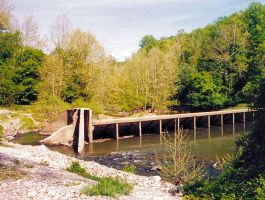| Fish Passage |
|
During their life cycles, many species of fish migrate among different habitats. For example, anadromous fish are fish that live mostly in the ocean, but breed in fresh water. In order to move between varying habitats—for example, swimming upstream to spawn—fish must be able to swim freely throughout their range. Dams and fish blockages impede this migration. Dams provide many benefits to modern society, but they contribute to the habitat degradation and declining fish populations. While many dams still provide an important function, others no longer provide the benefits for which they were built. Others have outlived their planned life expectancy and are safety concerns. Other physical barriers to fish passage exist in the watershed, including “perched” road crossing culverts and culverts that are too narrow, steep, or collapsed. These can present impassible obstacles for migratory fish trying to reach their spawning grounds. More than 5,000 miles of fish spawning habitat on Bay tributaries are currently blocked by dams, culverts, and other man-made obstructions. There are more than 5,000 known fish blockages in the Chesapeake Bay. Since 1988, the Chesapeake Bay Program's Fish Passage Workgroup has opened 2,807 mies of habitat to migratory and resident fish in the Chesapeake Bay. A goal of the 2014 Chesapeake Bay Watershed Agreement is to open 1,000 additional miles by 2025. In 2011, 148 miles were opened; in 2012, 34; and in 2013, 33. The NOAA Restoration Center, primarily through the Community-based Restoration Program, has funded and implemented dam removal and fish passage projects throughout the Chesapeake Bay watershed, principally for the benefit of river herring (e.g., blueback, alewife), American shad, and American eel. Through authority granted by legislation, including the Federal Power Act, the Fish and Wildlife Coordination Act, and the essential fish habitat provisions of the Magnuson-Stevens Act, NOAA Fisheries uses several methods to protect diadromous fish and their habitat to ensure fish passage. These methods, implemented by efforts including NOAA’s Office of Habitat Conservation, are intended to allow fish to get past barriers and to improve and protect historic and existing river habitat. NOAA accomplishes these goals by requiring fishways, such as “fish ladders,” at hydropower dams that help fish migrate around dams; recommending conditions in dam licenses that help protect fish and wildlife from dam operations; and working with federal permitting agencies to ensure the activities they permit do not harm fish habitat or the surrounding watersheds. |



